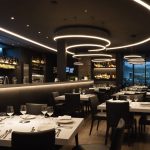Natural light transforms any kitchen, creating an inviting atmosphere while enhancing functionality. The orientation of your home significantly dictates how much sunlight enters your space throughout the day. By understanding your kitchen’s positioning, you can maximize illumination and energize your cooking environment. This exploration reveals how to harness natural light effectively, making your kitchen not just a culinary hub but also a bright, warm gathering space. Discover the impact of orientation and elevate your kitchen’s design.
The Importance of Home Orientation in Kitchen Lighting
Understanding home orientation is crucial when considering kitchen lighting. The direction your home faces significantly affects the amount of natural light that enters your kitchen. For instance, a kitchen facing south typically enjoys more sunlight throughout the day, which can enhance both its functionality and aesthetics. In contrast, a north-facing kitchen might require additional artificial lighting to compensate for the lack of sunlight.
In parallel : Unlocking Kitchen Safety: Harnessing IoT Devices for a Safer Culinary Experience
Kitchen lighting plays a pivotal role not just in functionality but also in creating a welcoming atmosphere. Properly positioned lights can highlight key areas, making cooking and cleaning tasks easier. Moreover, the right lighting can transform the kitchen into a cosy, inviting space for family gatherings.
The presence of natural light in a kitchen impacts more than just visibility. It can improve mood, making the kitchen a more pleasant place to spend time. Additionally, harnessing natural light can lead to energy savings, reducing the need for artificial lighting during the day. This not only lowers energy bills but also contributes to a more sustainable living environment. Therefore, considering home orientation when planning kitchen lighting is both a practical and environmentally friendly choice.
Also read : Chic Ways to Integrate Acoustic Panels into Your Kitchen Design
Effects of Different Orientations on Kitchen Illumination
Understanding how your kitchen’s orientation affects illumination can guide your lighting choices.
North-Facing Kitchens
North-facing kitchens often receive indirect light, resulting in a cooler and dimmer atmosphere. This orientation might require strategic artificial lighting to enhance visibility and warmth. Consider using layered lighting, which combines ambient, task, and accent lighting to create a balanced environment.
South-Facing Kitchens
South-facing kitchens benefit from abundant sunlight throughout the day. This orientation is ideal for maximizing natural light, creating a bright and inviting space. However, it may also lead to glare or overheating. Employing blinds or light-diffusing curtains can help manage these issues while preserving warmth and brightness.
East-Facing Kitchens
An east-facing kitchen enjoys morning sunlight, which can create a cheerful and invigorating start to the day. However, the light diminishes in the afternoon. To maintain consistent illumination, consider installing adjustable lighting fixtures that can adapt to changing light conditions.
West-Facing Kitchens
West-facing kitchens receive strong afternoon light, which can add warmth and vibrancy. However, this can also cause overheating in warmer months. Incorporating reflective surfaces and light colours can help diffuse the intense light, creating a pleasant and balanced kitchen environment.
Optimizing Kitchen Layouts for Natural Light
Maximizing natural light in your kitchen layout is both an art and a science, combining elements of interior design with practical planning. The strategic placement of windows and skylights is a crucial consideration. For instance, installing larger windows on the south or east-facing walls can significantly increase the influx of sunlight, making the room feel more open and airy. Skylights are another effective option, particularly in kitchens where wall space is limited.
Reflective surfaces play a pivotal role in light optimization. By incorporating materials such as glossy tiles, stainless steel appliances, or glass cabinet doors, you can amplify the available light, creating a brighter environment. Similarly, choosing lighter colour schemes for walls and cabinetry can enhance this effect, reflecting more light throughout the space.
When planning your kitchen layout, consider how these elements work together to create an optimal lighting environment. Interior design choices, such as the arrangement of furniture and the selection of finishes, should aim to enhance the natural light, making the kitchen not only functional but also inviting. This harmonious blend of design and functionality can transform your kitchen into a vibrant and energy-efficient hub of your home.
Design Solutions for Enhancing Kitchen Light
Incorporating effective lighting design during a kitchen renovation can dramatically transform your cooking space. By employing strategic design solutions, you can enhance both the functionality and aesthetics of your kitchen.
Incorporating Artificial Lighting
Artificial lighting is essential for creating a well-lit kitchen environment. Consider installing a combination of ambient, task, and accent lighting. Ambient lighting provides general illumination, while task lighting focuses on specific areas like countertops and stoves. Accent lighting adds depth and highlights architectural features. Using dimmable fixtures allows for flexibility, adapting the light intensity to suit different activities and times of day.
Window Treatments and Their Impact
Window treatments play a significant role in controlling light flow. Sheer curtains or blinds can diffuse harsh sunlight while maintaining a bright atmosphere. For kitchens with excessive glare, consider using light-diffusing shades. These treatments help regulate the amount of natural light entering the space, balancing brightness and comfort.
Using Mirrors and Reflective Materials
Mirrors and reflective surfaces can amplify natural light, making the kitchen appear larger and brighter. Positioning mirrors opposite windows can reflect light throughout the room. Incorporating reflective materials, such as glass tiles or stainless steel, can further enhance light distribution, creating a vibrant and inviting kitchen.
Case Studies: Successful Kitchen Designs with Optimal Natural Light
Exploring real-life examples of kitchens that have successfully harnessed natural light can offer valuable insights for your own home. By examining these case studies, you can understand how strategic design choices can transform a space.
Example 1: The Urban Loft Kitchen
In an urban setting, a loft kitchen was redesigned to maximise natural light. The renovation involved installing large, south-facing windows and incorporating reflective surfaces like stainless steel and glass. These elements not only enhanced the light but also created a sense of openness and warmth.
Example 2: The Suburban Family Kitchen
A suburban kitchen underwent a significant transformation by adding skylights and using a light colour palette. Before the renovation, the space felt cramped and dim. Post-renovation, the kitchen became a vibrant hub, with increased natural light making it more inviting and energy-efficient.
Lessons Learned
- Strategic window placement can significantly increase light flow.
- Reflective materials amplify available light, creating a brighter atmosphere.
- Colour choices impact light distribution, with lighter tones enhancing brightness.
These examples illustrate how thoughtful design can optimise natural light, improving both aesthetics and functionality.
Visualizing Natural Light Patterns in Kitchens
Understanding light patterns in your kitchen is essential for effective design. Visual aids like graphics can significantly enhance comprehension of how light flows in different orientations. These visuals serve as powerful tools for both designers and homeowners, offering a clear representation of how natural light interacts with kitchen spaces throughout the day.
Diagrams are particularly useful in illustrating these patterns. For instance, a graphic showing the trajectory of sunlight in a south-facing kitchen can help identify areas that receive the most light, guiding decisions on window placements and furniture arrangements. Similarly, diagrams for north-facing kitchens can highlight zones that might benefit from additional artificial lighting.
Utilizing kitchen design visuals can effectively communicate design ideas. They provide a tangible reference that can be easily shared and discussed, ensuring that all parties involved in the renovation or design process have a unified understanding of the light dynamics. By using these tools, you can make informed decisions that enhance both the functionality and aesthetics of your kitchen, creating a space that is well-lit and inviting.






